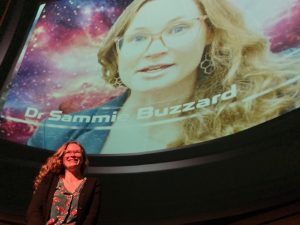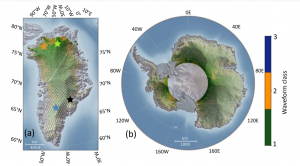The Centre for Polar Observation and Modelling (CPOM) provides the UK with core strategic national capability in satellite observation and numerical modelling of the polar regions. Our mission is to understand how their ice, oceans, and climate are changing.
CPOM uses theoretical and laboratory-derived information to form new models of interactions between the ice, ocean and atmosphere, and uses ground and satellite observations to test these and other climate models.
Latest News
07.10.24
New £8.4M investment continues support for long-term polar science, co-led by the British Antarctic Survey (BAS) and UK’s Centre for Polar Observation and Modelling (CPOM). New £8.4M investment continues support for long-term polar science. Find out more about our PRESCIENT programme in partnership with the British Antarctic Survey, funded by the UK National Environment Research Council.
11.07.2024
CPOM’s Dr Sammie Buzzard features in stunning new planetarium show at Life Science Centre.
15.05.24
In our #CPOMOriginStories series we are talking to our scientists about how they first got involved with polar science. In the first of the series we spoke to CPOM PI, Dr Rosemary Willatt about her route into studying sea ice.
09.04.24
New research shows restoring ice melt rates in The Amundsen Sea Embayment to present-day levels within the next century could limit ice discharge and sea level contribution, however a long-term increase in ice accumulation is necessary to reverse ice loss in the region.
19.03.24
CPOM’s Dr Inès Otosaka (Northumbria University) gave evidence today to the Environmental Audit Sub-Committee on Polar Research as part of The UK and Antarctic Environment Enquiry.
13.03.24
CPOM’s Prof. Andrew Shepherd and Dr Sammie Buzzard in POP23 video
CPOM Director Prof Andrew Shepherd and CPOM Assistant Director Sammie Shepherd discuss the importance of protecting our polar regions and how we monitor them here at CPOM in this educational video from the Protecting Our Planet 2023 event run by Stem Learning.
13.02.24
Examining the Antarctic and Greenland Ice Sheets and their impact on future sea level rise
New research states that future rises in sea level could be better estimated by gaining a clearer understanding of the Antarctic and Greenland ice sheets.
08.02.24
CPOM publishes paper in The Cryosphere
This research compares different ways of measuring the depth of supraglacial lakes, using tools including a radiative transfer equation (RTE), ArcticDEM digital elevation models, and ICESat-2 photon refraction. The team of researchers led by CPOM PhD Researcher Laura Melling (Lancaster University) applied these methods to five lakes in southwest Greenland.
06.02.24
CPOM publishes paper in Remote Sensing of Environment
CPOM publishes paper ‘Multipeak retracking of radar altimetry waveforms over ice sheets’ in Remote Sensing of Environment, introducing a new processing approach, aimed at overcoming challenges associated with using radar altimetry to measure ice sheet changes over rugged coastal topography in Antarctica and Greenland.
29.01.24
JOB ROLE: Senior Research Associate in Ice Sheet Geodesy
25.01.24
Dr Sammie Buzzard discusses the world’s largest iceberg A23a
23.01.24
What is ‘firn’, and how does it impact the Greenland and Antarctic ice sheets?
CPOM Director Assistant Professor Sammie Buzzard and CPOM Research Fellow Dr Athul Kaitheri (both of Northumbria University) co-author ‘Firn On Ice Sheets’, with The Firn Symposium Team, published today in Nature Reviews Earth and Environment (23.1.24). Read the story here.
09.11.23: AI can map giant icebergs from satellite images 10,000 times faster than humans
CPOM researchers have trained an artificial intelligence (AI) system to accurately map the surface area and outline of giant icebergs captured on satellite images in just one-hundredth of a second. Read the full story here.
20.04.23: The IMBIE Team releases a new assessment of ice sheet mass balance today showing that the ice sheets lost 7,560 billion tonnes of ice between 1992 to 2020
The seven worst years for polar ice sheets melting and losing ice have occurred during the past decade, according to new research, with 2019 being the worst year on record. Read the full story here.
Highlights
CPOM contributes to Environment Audit Committee Report on the Arctic
The Environment Audit Committee, which scrutinises the UK Government’s performance on environmental protection and sustainable development, produced a report in October 2023, “What happens in the Arctic doesn’t stay in the Arctic”, which called for better focus on Arctic issues in Whitehall and a funding boost for research.
CPOM responded to the Inquiry’s calls for evidence in the Spring of 2023, and CPOM Director Professor Andrew Shepherd (Northumbria University) attended the Inquiry in person to provide information and data from CPOM’s research, to contribute to their report.
We were heartened to see CPOM recommendations and suggestions included in the final report which can be read, downloaded and viewed here.
We look forward to seeing the impact of this enquiry and report in the future.
World’s ice is melting faster than ever – join Andy Shepherd as he discusses how long-term satellite observations from ESA’s Climate Change Initiative are key in monitoring changes in ice sheets over decade.
CPOM research shows global warming has caused extreme ice melting events in Greenland to become more frequent and more intense over the past 40 years, raising sea levels and flood risk worldwide.
CPOM research shows that global ice loss increases are at record rate
Sea level rise matches worst-case scenario
Six-fold increase in polar ice losses since the 1990s








